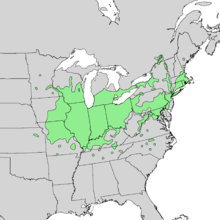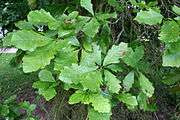Quercus bicolor
| Swamp white oak | |
|---|---|
 | |
| Morton Arboretum acc. 71-69-2 | |
| Scientific classification | |
| Kingdom: | Plantae |
| (unranked): | Angiosperms |
| (unranked): | Eudicots |
| (unranked): | Rosids |
| Order: | Fagales |
| Family: | Fagaceae |
| Genus: | Quercus |
| Section: | Quercus |
| Species: | Q. bicolor |
| Binomial name | |
| Quercus bicolor Willd. 1801 | |
 | |
| Natural range | |
| Synonyms[1][2] | |
|
List
| |
Quercus bicolor, the swamp white oak, is a North American species of medium-sized trees in the beech family. It is a common element of America's north central and northeastern mixed forests. It can survive in a variety of habitats. It forms hybrids with bur oak where they occur together in the wild.
Description
Quercus bicolor grows rapidly and can reach 60 to 80 feet (18 to 24 meters) tall with the tallest known reaching 29 m (95 ft) [3] and lives up to 350 years. The bark resembles that of the white oak. The leaves are broad ovoid, 12–18 cm (4 3⁄4–7 in) long and 7–11 cm (2 3⁄4–4 1⁄4 in) broad, always more or less glaucous on the underside, and are shallowly lobed with five to seven lobes on each side, intermediate between the chestnut oak and the white oak. In autumn, they turn brown, yellow-brown, or sometimes reddish, but generally, the color is not as reliable or as brilliant as the white oak can be. The fruit is a peduncled acorn, 1.5–2 cm (5⁄8–3⁄4 in) (rarely 2.5 cm or 0.98 in) long and 1–2 cm (3⁄8–3⁄4 in) broad, maturing about 6 months after pollination.[4]
|
Habitat
The swamp white oak generally occurs singly in four different forest types: black ash-American elm-red maple, silver maple-American elm, bur oak, and pin oak-sweetgum. Occasionally the swamp white oak is abundant in small areas. It is found within a very wide range of mean annual temperatures from 16 to 4 °C (61 to 39 °F). Extremes in temperature vary from 41 to −34 °C (106 to −29 °F). Average annual precipitation is from 640 to 1,270 mm (25 to 50 in). The frost-free period ranges from 210 days in the southern part of the growing area to 120 days in the northern part. The swamp white oak typically grows on hydromorphic soils. It is not found where flooding is permanent, although it is usually found in broad stream valleys, low-lying fields, and the margins of lakes, ponds, or sloughs.
Range
Swamp white oak, a lowland tree, is widespread in the eastern and central United States and eastern and central Canada, from Nova Scotia to South Carolina, west as far as Ontario, Minnesota, and Tennessee with a few isolated populations in Nebraska and Alabama. This species is most common and reaches its largest size in western New York and northern Ohio.[5][6]
Cultivation and uses
It is one of the more important white oaks for lumber production. In recent years, the swamp white oak has become a popular landscaping tree, partly due to its relative ease of transplanting.
Being in the white oak group, wildlife such as deer, ducks, and geese, as well as other animals are attracted to this tree when acorns are dropping in the fall.
Cultivars
Quercus robur fastigiata x Quercus bicolor 'Nadler' Kindred Spirit Hybrid Oak
References
- ↑ Tropicos, Quercus bicolor
- ↑ The Plant List, Quercus bicolor
- ↑ Muhlenberg, Ges. Naturf. Freunde Berlin Neue Schriften. 3: 396. 1801.
- ↑ "Quercus bicolor". Flora of North America (FNA). Missouri Botanical Garden – via eFloras.org.
- ↑ Burns, Russell M.; Honkala, Barbara H., eds. (1990). "Quercus bicolor". Hardwoods. Silvics of North America. Washington, D.C.: United States Forest Service (USFS), United States Department of Agriculture (USDA). 2. Retrieved 14 December 2009 – via Northeastern Area State and Private Forestry (www.na.fs.fed.us).
- ↑ "Quercus bicolor". County-level distribution map from the North American Plant Atlas (NAPA). Biota of North America Program (BONAP). 2013.
| Wikimedia Commons has media related to Quercus bicolor. |
External links
- United States Department of Agriculture Plants Profile: Quercus bicolor
- United States Department of Agriculture, National Forest Service, Silvic Manual: Quercus bicolor
- Quercus bicolor images from Vanderbilt University
- photo of herbarium specimen at Missouri Botanical Garden, collected in Missouri in 1934
